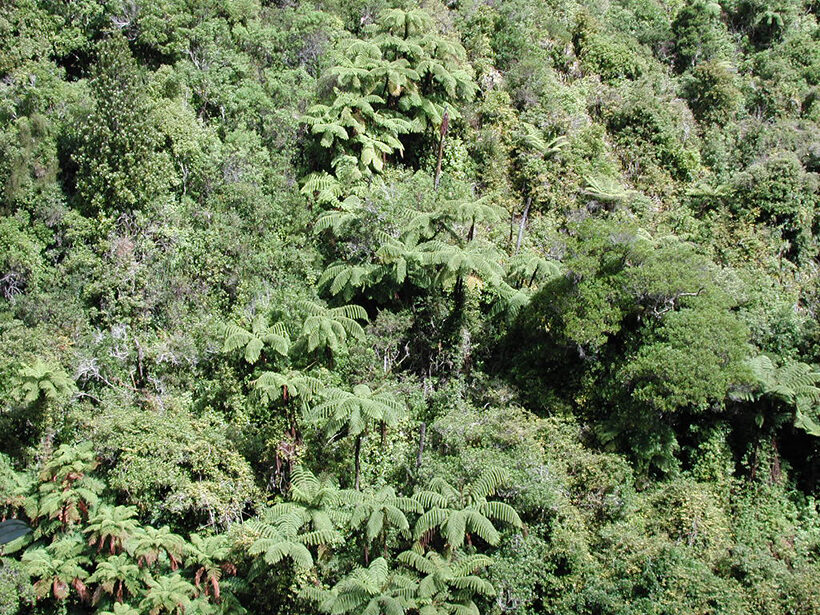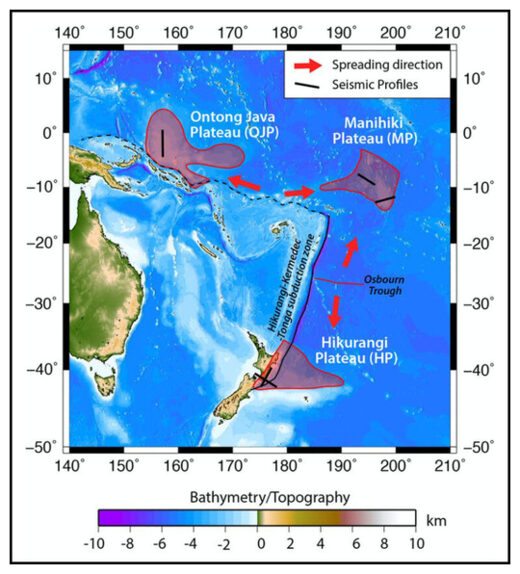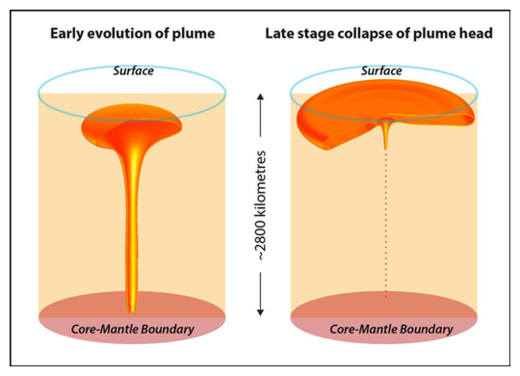
The source of such extreme volcanism could have been a giant mantle plume, or superplume, according to new evidence published in Science Advances in May. First proposed in the 1970s, the plume hypothesis has become the mainstream explanation for volcanism that occurs far from plate boundaries — though a vocal minority has pointed out that physical evidence for plumes' existence remains thin.
According to plume theory, a plume is born where Earth's core meets its mantle, forming an expanding blob that gradually travels toward the crust. Heat from the head of the plume is thought to melt the crust above it and cause hot spot volcanoes, like those making up the island chain of Hawaii.
Picture a lava lamp, said Simon Lamb, a geophysicist at Te Herenga Waka-Victoria University of Wellington (VUW) in New Zealand and coauthor of the new research. "Once in a while, one of these blobs is just unusually large" — a superplume, Lamb said. He and his colleague Tim Stern, also a geophysicist at VUW, said they've found some rare evidence for one.
Convenient Quakes

In 2012, for a study on the structure of the subduction zone where the Pacific and Australian plates meet, Stern and his colleagues placed an array of 875 seismographs above the Hikurangi Plateau. The array stretched from the west coast to the east coast of New Zealand's North Island, with one device every 100 meters. The team planned to set off explosions and measure the speed at which seismic vibrations traveled vertically through the crust.
Conveniently, a number of earthquakes occurred offshore during the 2-week period when the seismometers were in place. The array of instruments was in just the right position for seismic waves to travel down the line, allowing the team to calculate how fast the waves traveled through the rocks of the Hikurangi Plateau.
"It was luck that we had this beautiful seismic array out, which gave us the ability to resolve these speeds with a very high accuracy," said Stern. "A lot of work in seismology is based on serendipity like that."
The results were unusual. Worldwide, seismic pressure waves travel through the upper mantle at around 8.1 kilometers per second. But beneath the Hikurangi Plateau, Stern and his colleagues reported significantly faster speeds of 8.7 to 8.9 kilometers per second.
In addition, although seismic waves usually travel faster in one direction, here they traveled just as fast in all directions within the horizontal plane — but much slower in the vertical one. In a separate experiment, coauthor Katharina Hochmuth (currently at the University of Leicester in the United Kingdom) found similar patterns under the Manihiki Plateau.
Pinning Down a Superplume
"This is a unique piece of evidence for plumes. It's a solid result," said Catherine Rychert, a seismologist at the University of Southampton in the United Kingdom who was not involved in the study. The high horizontal speeds suggest olivine crystals in the mantle were almost all aligned, she says, producing an unusual and strong rock fabric.
Lamb discovered this same fabric had previously been found in rock samples that had been dredged up from the seafloor in the western Pacific. An added piece of evidence came from the lab: When other researchers had squashed mantle rocks under huge pressure, they also created this kind of fabric with the olivine crystals similarly aligned.
Put together, Stern and Lamb argued the patterns could be explained by a superplume at the end of its life. When the blob reached its maximum height in the mantle, it collapsed under gravity and flowed gradually out in all directions, flattened by pressure above and below.
"It's a bit like if you imagined pancake mix being poured into a pan: The mixture spreads in all directions at once," Stern said.

"This is the first clear seismic evidence for the existence of a mantle plume for Ontong Java," said Ian Campbell, a geologist at the Australian National University also not involved in the research. "It's one more line of evidence that confirms the predictions made by plume theory."
But Gillian Foulger, a geophysicist at Durham University in the United Kingdom and a prominent plume skeptic, said this new paper hasn't provided a smoking gun. Although the field project was "brilliant," she said the mapping and modeling are "an infinitely long way from having found a mantle plume or having proved it's there or having ruled out any other hypotheses."
Applying these methods to sites of other possible large plumes is an obvious next step, Rychert said. "It would be useful to go and see if we can observe these kinds of speed patterns under other large igneous provinces."
One location where such high seismic speed patterns have already been reported is beneath the Siberian Traps. The traps are a large igneous province that, 250 million years ago, was the site of the second-largest volcanic outpouring in history and may have been responsible for the Permian-Triassic mass extinction event that extinguished 96% of life on Earth.
Unraveling how superplumes function — and whether they exist at all — goes "right to heart of the way our planet works," Lamb said.
Citation: Evans, K. (2020), New evidence of a giant lava lamp beneath the ancient Pacific, Eos, 101, https://doi.org/10.1029/2020EO146449. Published on 01 July 2020.



R.C.